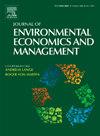自然灾害与医疗保险需求
IF 5.9
3区 经济学
Q1 BUSINESS
Journal of Environmental Economics and Management
Pub Date : 2024-12-20
DOI:10.1016/j.jeem.2024.103108
引用次数: 0
摘要
随着人们对自然灾害风险的日益关注,本研究率先探究了飓风对澳大利亚私人健康保险(PHI)需求的因果影响。我们将具有全国代表性的纵向数据集与历史气旋记录合并,采用单个固定效应模型来评估各种外源确定的气旋暴露措施的影响。我们的研究结果表明,只有最严重的5级气旋在同期和随后的年份显著增加了个体获得PHI的可能性。此外,随着离气旋眼距离的增加,这种影响会减弱。最大的累积影响估计超过5个百分点,约占样本平均值的11%,与旨在提高覆盖范围的某些PHI政策的记录效果一致。此外,我们的研究结果经受住了一系列的敏感性评估,包括安慰剂试验和三次随机试验。此外,飓风对年轻人、社会经济地位较高的个人以及沿海或历史上受飓风影响地区的居民的影响更为明显。此外,在排除了收入、转移支付、健康状况和保费作为机制后,我们的研究提供了暗示性的证据,表明气旋引起的家庭破坏和心理压力的增加是气旋增加PHI摄取的合理途径。本文章由计算机程序翻译,如有差异,请以英文原文为准。
Natural disasters and the demand for health insurance
Amidst growing concerns over heightened natural disaster risks, this study pioneers an inquiry into the causal impacts of cyclones on the demand for private health insurance (PHI) in Australia. We amalgamate a nationally representative longitudinal dataset with historical cyclone records, employing an individual fixed effects model to assess the impacts of various exogenously determined cyclone exposure measures. Our findings reveal that only the most severe category 5 cyclones significantly increase the likelihood of individuals acquiring PHI in both the concurrent and subsequent years. Furthermore, the effect diminishes as the distance from the cyclone's eye increases. The largest estimated cumulated impact amounts to over 5 percentage points, representing approximately 11% of the sample mean and aligns with documented effects of certain PHI policies aimed at enhancing coverage. Furthermore, our findings withstand a series of sensitivity assessments, including a placebo test and three randomization examinations. Moreover, the cyclone impacts are more pronounced for younger demographics, individuals of higher socioeconomic status, and inhabitants of coastal or historically cyclone-affected areas. Additionally, after ruling out income, transfers, health status, and premiums as mechanisms, our study furnishes suggestive evidence that cyclone-induced home damage and heightened psychological stress are plausible pathways through which cyclones increase PHI uptake.
求助全文
通过发布文献求助,成功后即可免费获取论文全文。
去求助
来源期刊
CiteScore
8.00
自引率
4.30%
发文量
91
期刊介绍:
The Journal of Environmental Economics and Management publishes theoretical and empirical papers devoted to specific natural resources and environmental issues. For consideration, papers should (1) contain a substantial element embodying the linkage between economic systems and environmental and natural resources systems or (2) be of substantial importance in understanding the management and/or social control of the economy in its relations with the natural environment. Although the general orientation of the journal is toward economics, interdisciplinary papers by researchers in other fields of interest to resource and environmental economists will be welcomed.

 求助内容:
求助内容: 应助结果提醒方式:
应助结果提醒方式:


